Generative technologies underpin a wide range of services — from personalized training and smart recommendations to automated content creation. Apps built on these technologies often climb rapidly to the top of the App Store and Google Play charts. RadASO closely monitors these trends, documenting how AI-driven products are reshaping the mobile app industry.
Releasing a high-quality application is only the first step. To succeed in a marketplace crowded with millions of apps, it’s essential to make yours stand out. This is where a well-crafted ASO (App Store Optimization) strategy becomes critical.
In this article, I will explore the most popular categories of AI-powered apps and highlight the key aspects of their ASO promotion.

The launch of ChatGPT in 2022 turned artificial intelligence into a mainstream phenomenon. Since then, both the number and the popularity of AI-driven services have grown at a rapid pace.
Number of apps adding AI-related search terms (iOS and Google Play)
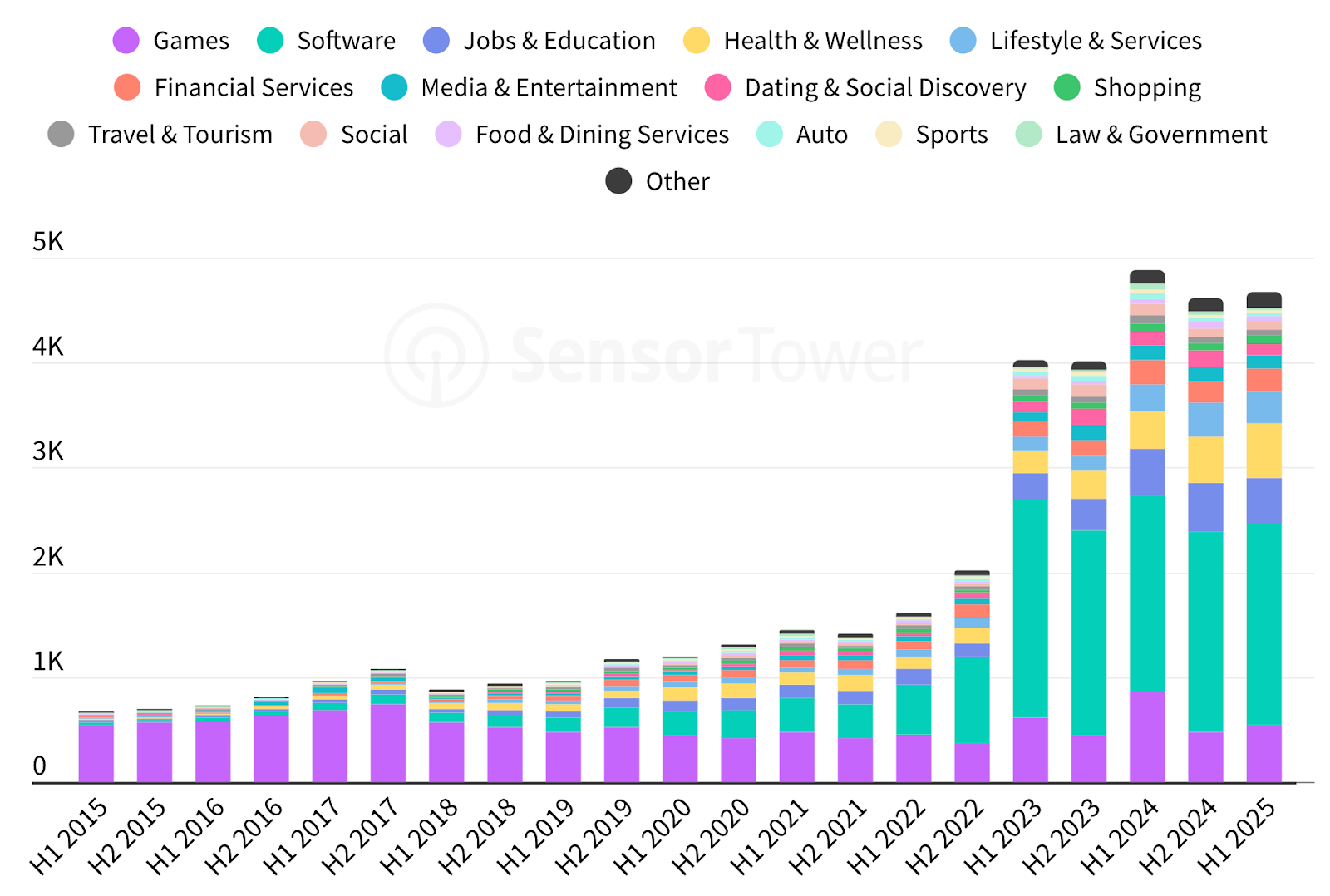
One of the most prominent and fast-growing categories is generative AI. These apps go beyond analyzing data or answering user requests — they actively create new content such as text, images, videos, music, and even code. By doing so, they help users save significant time and resources.
In the first half of 2025, downloads of generative AI applications rose by 67% compared to the previous six months, reaching nearly 1.7 billion.
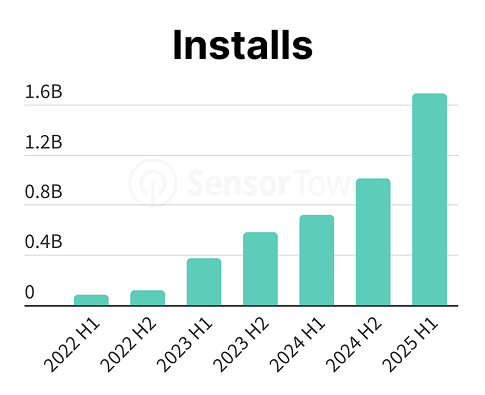
These services fall into two main categories: virtual assistants and content generators.
The emergence of ChatGPT accelerated the widespread adoption of AI-powered assistants and chatbots. Their popularity continues to grow, with users turning to them not only for information and entertainment but also for emotional support, communication, planning, and learning.
ChatGPT, of course, took the leading spot in this category. In July 2025, it became the fastest app to reach one billion total downloads. Other notable players include Google Gemini, DeepSeek, Replika, Genie.
Features:
Services that generate images, music, or videos are rapidly gaining popularity, as they allow anyone to create content regardless of talent or skill level.
Examples: Lensa, WOMBO Dream, Remini, Canva, Suno.
However, these services also have drawbacks: results can sometimes be disappointing, certain tools tend to overpromise, and full functionality is often locked behind costly subscriptions.
Artificial intelligence makes learning more accessible, adaptive, and interactive.
AI assistants help students write texts and essays, generate ideas, and better understand school subjects — from recognizing formulas to explaining complex material.
For example, Socratic, AI Homework Helper, Grammarly, Notion, AI Writer.
AI tutors, such as Quizlet, create personalized learning plans, adjust task difficulty to match the user’s level, and provide instant feedback.
Where would we be without apps for learning foreign languages that use speech recognition technology to analyze pronunciation and offer personalized recommendations for improvement? Notable examples include Duolingo, EWA, Busuu.
Healthcare and medicine. AI is increasingly used for diagnosis, health monitoring, symptom analysis, and providing users with preliminary information to better understand their condition. A key example is Ada Health.
Sports trackers. These apps analyze data on physical activity, sleep, and mood, then provide personalized recommendations for training, nutrition, and meditation. Notable examples include Fitbod and Meditopia.
Financial assistants. These apps analyze financial flows, forecast expenses, and offer personalized advice on saving and investing. Examples include Copilot, Rocket Money, Peek.
Mental well-being. Used for emotional support, coaching, and condition tracking, e.g., Wysa, Youper.
E-commerce & fashion. These apps let users virtually try on clothes, receive personalized style recommendations, and build digital wardrobes. Examples: Whering, StyleDNA, Acloset.
Home/interior design. These apps help users find renovation ideas, choose decor or furniture, and create realistic visualizations. Examples include Home Planner, Remodel AI, AI Garden Design.



An innovative AI-based service can easily get lost among millions of competing apps. That’s where ASO comes in — the process of optimizing App Store and Google Play pages to boost visibility and drive downloads. As the RadASO team points out, ASO has its own specific nuances when it comes to AI applications.
Use specialized tools (such as Asolytics) to collect popular local AI-related keywords that are relevant to your application.
Pay close attention to keywords that cover not only the app category (e.g., “photo editor,” “fitness tracker”) but also AI-specific terms such as “AI,” “AI photo enhancer,” “AI chat,” or “image generator.” Since users frequently search with these phrases, it’s important to build a comprehensive semantic core that also includes popular long-tail keywords.
For established products, it’s best to place the well-known brand name first — for example, ChatGPT — AI Assistant. For new products, start with the core function and then add “AI,” such as AI Chatbot — Nova.

Regularly monitor trending search terms — they change very quickly in this field (for example, AI avatar → AI headshot) — and adjust your metadata accordingly.
Icons, screenshots, and videos can “sell” an app even before it is even downloaded.
Icon — It should be modern, minimalistic, and clearly associated with the app’s niche. Avoid outdated design elements and strive to make it as recognizable as possible.
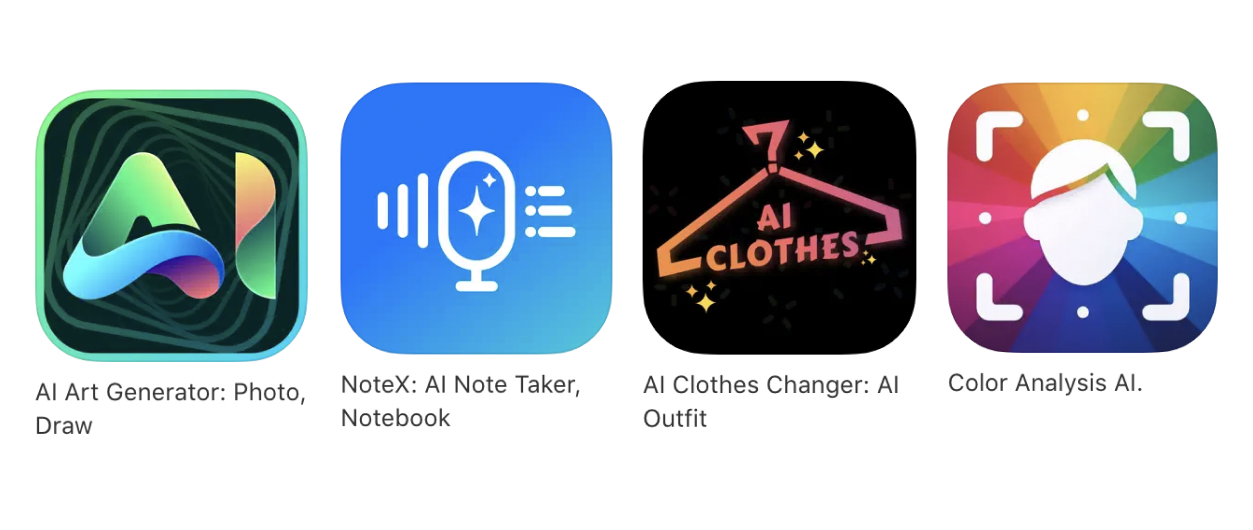
Screenshots — They should showcase not just the interface but also the outcomes of AI in action. For example: “before/after” comparisons in a photo editor, sample conversations in a chatbot, or graphs and personalized recommendations in a fitness tracker.

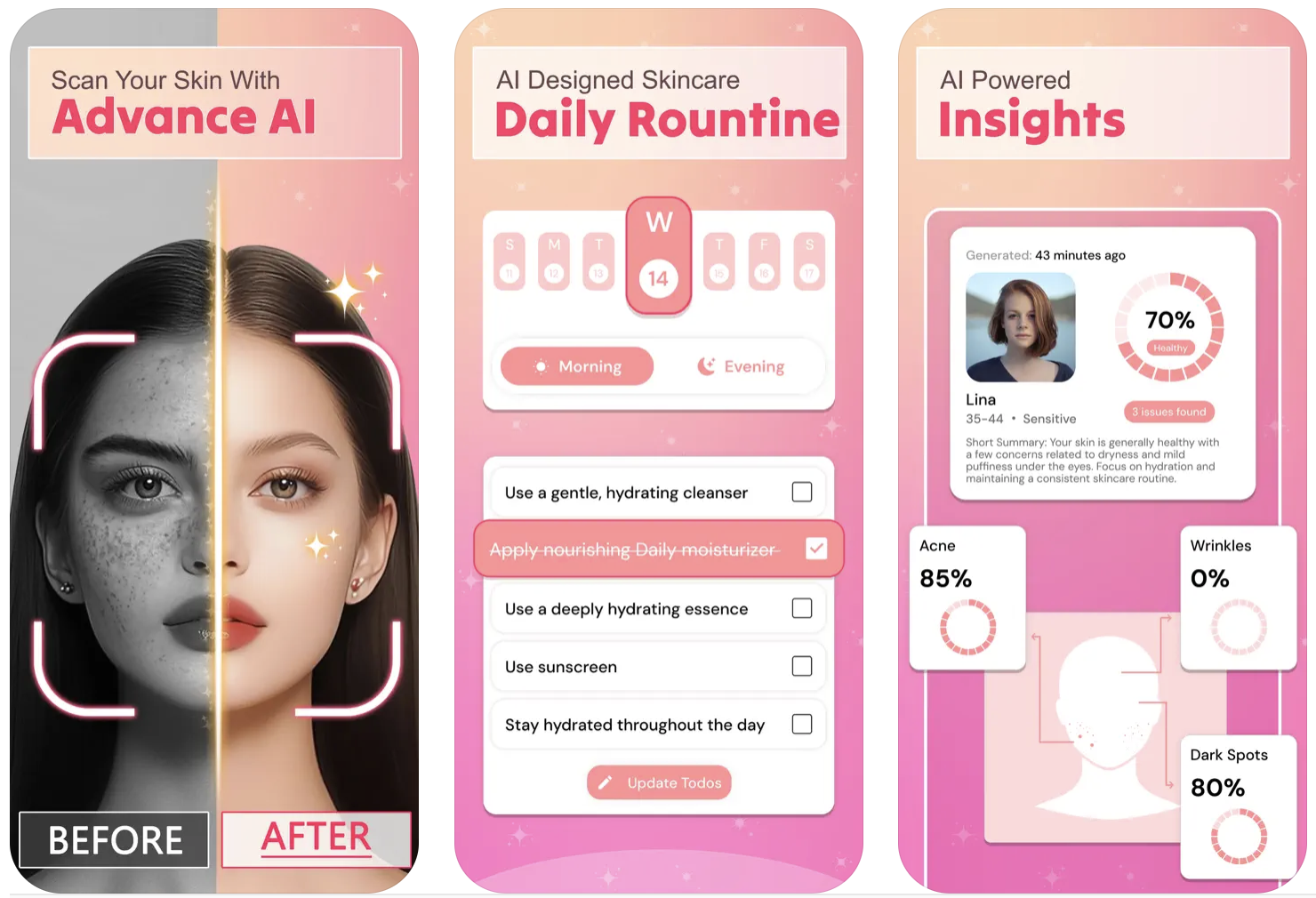

Video — One of the most powerful promotional tools, it creates a “wow effect” while demonstrating how simple and accessible artificial intelligence can be.
Short videos are especially effective for generative products, as video is often the first element users notice.
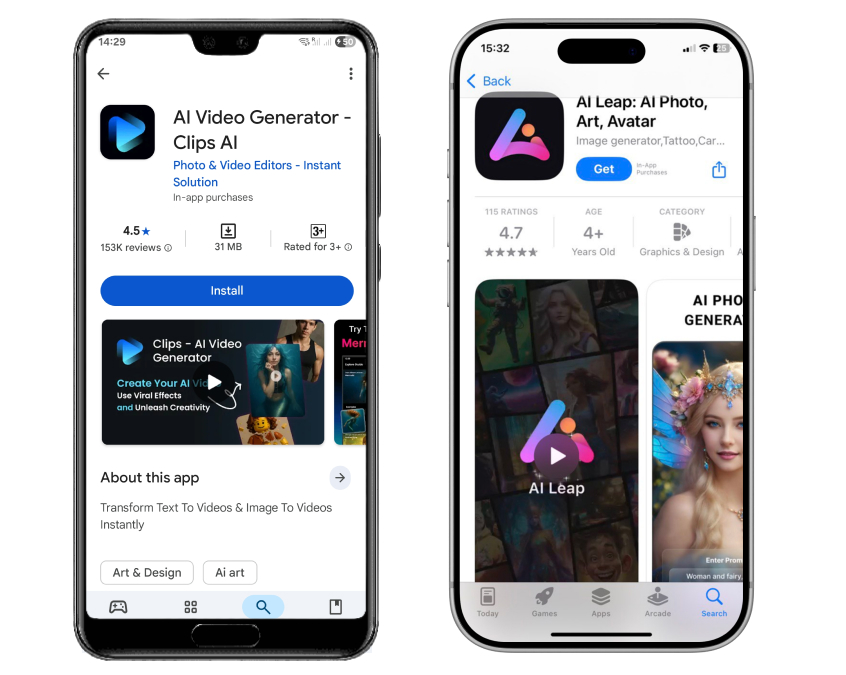
Learn more in the blog:
User ratings and reviews have a direct impact on both conversion and product reputation. Negative feedback is most often linked to paid features or unrealistic expectations, which is why it’s essential to manage reviews systematically:
Read our blog post How proper localization ensured a 452% increase in impressions and a 1600% increase in downloads in China.
AI applications have global potential, making it essential to localize the name, description, and screenshots for each target market. Adapt not only the language but also cultural nuances and the search terms most popular in those regions.
Read more in the blog about the impact of cultural and national characteristics on localization.
Leverage In-App Events and Custom Product Pages to segment traffic and capture your target audience’s attention. For instance, events can spotlight new AI features or special offers, while CPP/CSL (Custom Product Pages/Custom Store Listings) can be tailored to specific countries, interests, or traffic channels — ultimately boosting conversion rates.
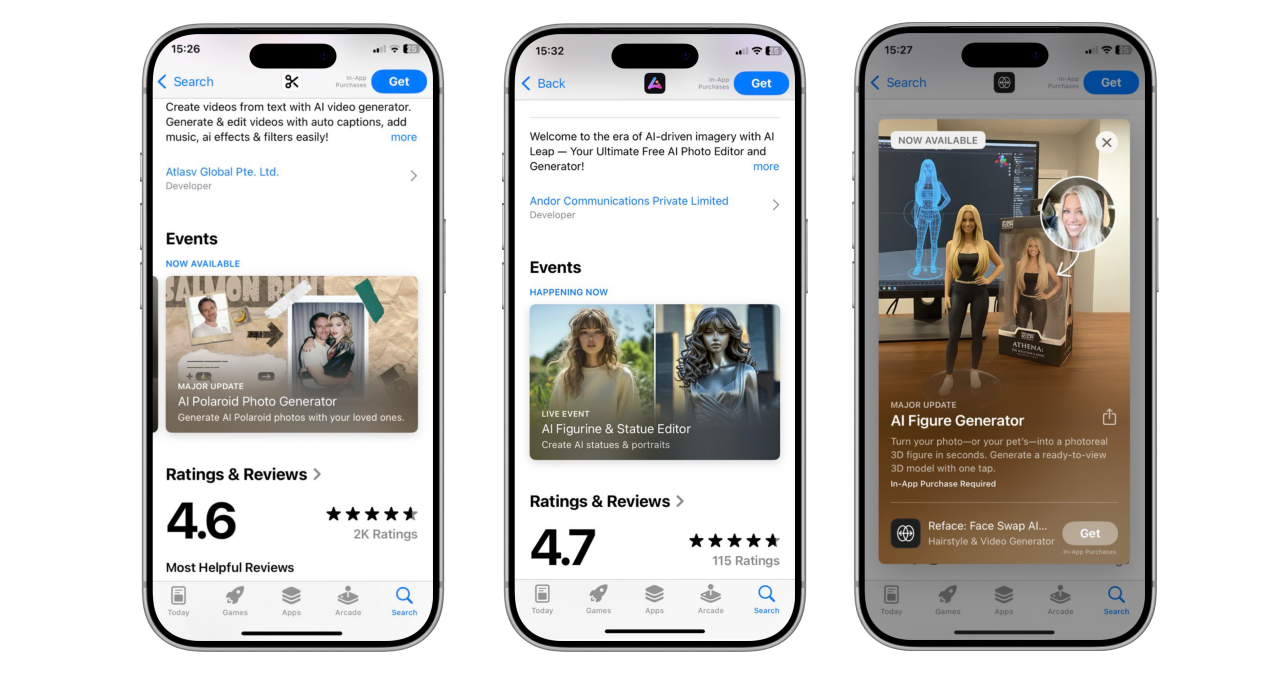
Regularly test different variations of text metadata, icons, and screenshots — including their order — to identify the optimal combinations that drive higher conversion and stronger audience engagement.
Continuously add new AI-related features and update your app store page to reflect them. This signals to users that the application is actively evolving and encourages repeat downloads.

For a product to succeed (and who doesn’t want that?), it’s important to anticipate key challenges and address them promptly.
Many countries are already introducing regulations on the use of artificial intelligence, focusing on areas such as:
To avoid removal or restrictions in the App Store or Google Play for policy violations, evaluate the legal and ethical aspects of your product before launch:
Many AI applications rely on standard interface templates, featuring identical generation screens, similar buttons, and repetitive color palettes. Even screenshots and videos can appear “like everyone else’s,” which can reduce click-through rates in search results.
Blindly copying competitors’ solutions won’t work. Study the market and gather inspiration, but focus on implementing your own ideas — using unique designs, animations, and interaction scenarios.
Many AI products rely on third-party model APIs (e.g., OpenAI, Stability, Anthropic), which entails certain risks:
It’s advisable not to rely on a single AI model provider. Maintain multiple alternatives in your toolkit, such as OpenAI, Anthropic, and Stability AI. Ideally, develop your own models tailored to your service to minimize dependence on external APIs.
When planning an AI application, it’s crucial not only to invest in promotion but also to minimize dependencies, create a unique user experience, and ensure compliance with all relevant regulations. Taking these steps will help you avoid the risks of app removal or restrictions on the store page.






































The success of an AI app depends on selecting the right category, understanding its features, and implementing a comprehensive ASO strategy. Key points include: